Ken Lizzi's Blog, page 3
May 18, 2025
The State of the Writer, May Edition
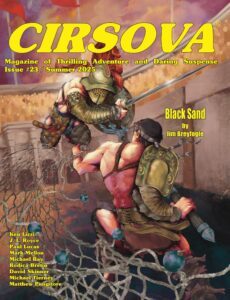
2025 is chugging along at a rapid clip. I’m a busy man. MBW and I are still trying to sell Casa Lizzi. Ups and downs, opportunities and disappointments. Nonetheless, we’re working on it. The HA is in nearly daily practices for a swim team. So that’s another hour of the day to be accounted for, scheduling it into the workday. And the writing continues. I’m at nearly the halfway point in the current work-in-progress.
Yet not all is in media res. Eventually some things reach completion. For example, you may have noted the image at the top of this post. Mark your calendars. That issue will be available in mid-June, about four weeks from the date of this writing. And, why yes, my name is one of those on the cover.
More news to come on 2025 publications. There are stages involved in getting a book from writer to reader. I’ll keep you updated on Cesar the Bravo as the publishing coach arrives at each new stage. I’ve already reviewed the proofs. I’ve seen the preliminary cover sketches.��I think you’re going to enjoy this one.
But if you want an actual book, rather than vague hints concerning a future book, grab one now. Or more than one. The Semi-Autos and Sorcery series is available in print, digital, and audio. The collected, four volume set is available in digital and audio. A good bargain. Of course, I am biased.
May 11, 2025
John Maddox Roberts’ “The Islander.”
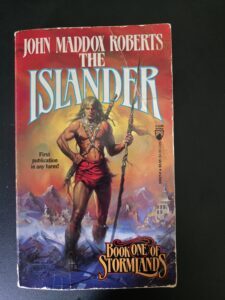
The first volume of John Maddox Roberts’ Stormlands series, The Islander, doesn’t read like a 380 page book. I had to slow down, pace myself, so as not to fly through the pages. This is heroic fiction done right.
The setting is post apocalyptic. I don’t know how far in the future the story is set, but all the animals appear to have mutated. Roberts doesn’t mention a single currently extant bit of fauna. The western coast of the US seems to have cracked off, leaving only islands. Nevada (the Kingdom of Neva) appears to be part of the coastline now, with its capital city the main port. The hero, Hael, is an inhabitant of a large island off the coast. After having recently finished Charles Saunders’ Imaro, I couldn’t help but note the similarities between Hael’s tribe of kagga herdsmen and Imaro’s cattle herders, and the stories of the individual protagonists. Both men begin as young warriors, spearmen. Both have to slay a particular dangerous cat to be initiated. And both are beset by a rival before ultimately being driven from the tribe.
Hael, ever curious and studious, takes ship from the island, learns about sailing and trading at various ports, before arriving at the mainland and the capital of Neva. There he rescues a noblewoman, is befriended (maybe) by her grateful father, and is rewarded by being enrolled in an exploratory expedition eastwards across the mountains. Roberts’ travelogue continues, never palling, always providing something new for the reader. Crossing the mountains, Hael again rescues a woman, Deena, an escaped captive of a nomadic tribe who ride mutated goats (“cabos.”) When the expedition meets the nomads, Hael defeats the one who’d captured Deena. He draws the attention of a tribal priest who recognizes Hael’s affinity with the supernatural and declares him a hero of prophecy. Hael, by this time, has begun having grand ideas. He returns Deena to her people, a forest dwelling tribe of longbow hunters. He conceives the notion of combining the two warring tribes into one, creating a sort of Hun-like tribe of horse-archers (or, rather cabo-archers.) The story concludes with a wedding, a sort of trial by fire of the first band of cabo-archers, and hazy prospects for the future.
At times the book reminded me vaguely of Crawford Killian’s Eyas. I ought to give that another read sometime.
There’s a lot going on in this novel. A great deal of clever, colorful world building, and plot points laid down for decanting in future volumes. I’m looking forward to the next, assuming it ever gets here. What is taking DHL so long? My only quibble with The Islander is the title; “Islander” doesn’t leap out at the reader, bloody sword in hand, screaming adventure. But nonetheless, that’s what you get once past the title, so I suppose it doesn’t much matter.
If you’re in the mood for adventure, pick up a copy of Islander. Or, if you’ve already read that one, try something of mine. Blood and Jade, for example.
May 4, 2025
Imaro Ascends to the Pantheon
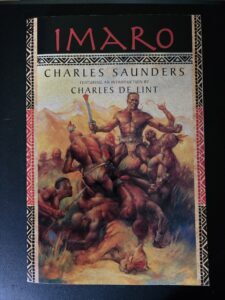
Charles Saunders’ sword-and-sorcery hero Imaro has been around for years, for most of my lifetime in fact. I’ve been aware of the character, encountering him in various anthologies. But until recently I’ve only scratched the surface of Saunders’ creation. With the purchase of the 2006 Night Shade edition of Imaro, I was finally able to delve more deeply, though there remains more to explore.
The book is the first of, apparently, four volumes narrating Imaro’s adventures. This one is his origin story, youthful adventures, and early manhood. It is a tragic, brutal, and bloody origin, establishing a character motivated by resentment, hate, and a desire to belong. Saunders builds a believable faux-Africa of varied topography, tribes, and civilizations. He writes vibrantly, painting vivid scenes. Imaro, in many ways a prototypical S&S protagonist, is generally a sympathetic character. He is not Conan and Saunders is not Robert E. Howard. Yet, have you seen those videos in which two different songs possess the same rhythmic structure and so the music aligns harmonically? This is similar: the music isn’t the same, but Imaro’s life (from what I’ve read so far) hits the same beats: the dangerous upbringing in a respected tribe, the early strength and youthful exploit, the joining of band of brigands, rise to its leadership, and its eventual violent dissolution at the hands of an army. All accompanied by the horrific supernatural elements necessary to sword-and-sorcery.
It’s all good stuff. And I reckon I’ll keep an eye out for book two. My only quibble — and that’s all it is, a quibble — is that I feel the stories would work better as standalones, published in magazines or anthologies, rather than stitched together in novel form. But I won’t let wishing for the perfect impede my enjoyment of the good. Recommended.
I also recommend picking up something of mine while you are waiting to get your hands on a copy of Imaro’s adventures. Perhaps Thick As Thieves also available in digital format. That one ought to keep you entertained.
April 27, 2025
Triplanetary: Cosmic Space Opera
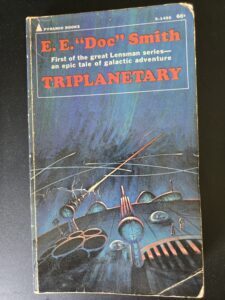
E.E. “Doc” Smith is noted for his creation of the Lensman series. Some credit these books as the wellspring from which flow such science-fictional organizations as The Green Lantern Corps or even the Jedi: super-powered, galaxy-spanning enforcers of justice. I don’t know. I’ve only read the first book, Triplanetary.
Triplanetary apparently sets the table for the rest of the series, providing the backstory. And what a backstory. Smith wasn’t thinking small. The story begins at galactic formation, in fact galactic formation in two different universes. We are introduced to the bad guys, the Eddorians, and the good guys, the Arisians. Both are essentially immortal and possessed of godlike mental powers. The Eddorians, amoeba-like lifeforms that desire only power and subjugation, believe they are supreme in the cosmos, unaware of the Arisians, who desire the advance and preserve Civilization. To that end, the Arisians begin a sort of eugenics program on Earth, advancing and developing certain bloodlines, all while the Eddorian agent is busily destroying human civilization as it crests.
The first half of the book is episodic, following one or more people unknowingly part of the Arisian breeding program during some cataclysmic event, starting with the fall of Atlantis. Once these reach the future (“19–?” the chapter heading reads) and a limited nuclear war, we get into the second half of the book. And the super science commences, fast and furious. It reminds me somewhat of the gonzo space opera of Jack Williamson’s Legion of Space, though less swashbuckling. The action is pellmell, events occurring within a paragraph that might easily occupy a chapter. But that speed helps smooth things along, glossing over the rather imperfect understanding of the consequences of traveling faster than light. (Being able to see, firing energy beams that somehow shoot ahead of the superluminal vessel, etc.) But this isn’t about the science. It’s about a boy and a girl, captures and escapes, battles in space, destruction on a massive scale, defeating the bad guy, and a happy ending. And at that it works. It is breezy fun, like a prose comic book. (Apparently the Lensman series has been adapted as Manga and American comics. There was also a movie and an anime series. It was Big in Japan.)
The “lens” was referenced a couple of times, but never shown or explained. So, if I want to learn any more, I’ll need to pick up the next book. I like to have something to keep an eye out for when browsing through used bookstores. And I may do so, but honestly I don’t feel that I’d be missing much if I didn’t pick up another volume.
If you’ve already read Triplanetary and don’t know what to pick up next, may I suggest something of mine? How about the Semi-Autos and Sorcery series?
April 20, 2025
“The Eagle of the Ninth” Still Flies.
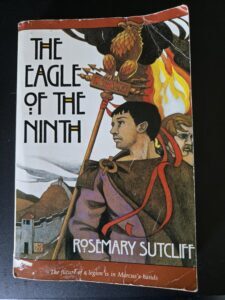
Rosemary Sutcliff had vision. Not only did she have vision, but she could share it with her readers. She could immerse us in detail, not only of the natural world, with the facility of Tolkien, but in period detail such clothing or architecture. And she did so with a seamless facility; nothing feels forced or awkwardly shoehorned into place to artificially provide color and verisimilitude.
The Eagle of the Ninth is an excellent example, its excellence all the more remarkable because it was one of Sutcliff’s earliest books. It is also only the third book of hers I’ve read, an oversight I intend to correct (though what I first read left an indelible impression.) It tells the story of�� Marcus, a cohort commander posted to Britain who searches for the lost Eagle of the Ninth Legion, which marched north nearly twenty years�� before and disappeared, a legion of which Marcus’ father was a centurion.
Sutcliff immediately drops the reader into Second Century Britain, with its sights, sounds, and smells; its juxtaposition of Roman and British cultures, both the positive and the violently lethal. She does fine with the characters as well. Marcus is likable and his motivations clear. Everyone should have an Uncle Aquila. And Esca provides a window into the mind of the native British. Even with minimal violent action scenes — confined primarily to the beginning and end of the book — Sutcliff maintains tension and the reader’s interest. It is Young Adult fiction, true, but it doesn’t suffer because of that. Another author, writing for adults, might have made it grittier, bloodier. But that wouldn’t have necessarily improved the story.
My only quibble — and it is a minor one — is that Marcus appears to possess anachronistically enlightened views for a Roman of his time and station. Again, this does nothing to hinder the story or my enjoyment of it.
I vaguely recall seeing the movie based on this, a Channing Tatum vehicle titled The Eagle. I don’t remember much about it, so other than mentioning its existence, I can’t really comment. But in a post about the book, the movie ought to at least be recognized.
Did you know there was a short film based on one of my stories? Well, there was.
I’m a tad bit under the weather today, so I will cut this short. But before I go, please buy my books. Thanks.
April 13, 2025
Harold Lamb’s “Alexander of Macedon.”
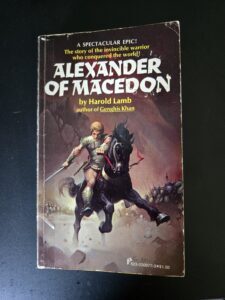
Without really meaning to I’ve become relatively familiar with the life and doings of Alexander the Great. He — whether as a main character or an essential secondary character — featured in any number of historical novels I picked up as a kid (e.g. Mary Renault’s books) and over the following decades. Most recently I read Steven Pressfield’s The Afghan Campaign. And in the course of studying history I’ve gone over his campaigns, battles, and political struggles. I even watched the Oliver Stone biopic. “Gaugamela”, “Issus”, “Chaeronea”, etc. are words I have at least some passing familiarity with (even if the auto-correct feature of WordPress does not.)
With that background I was comfortable picking up Harold Lamb’s Alexander of Macedon. I’ve been wanting to read more Lamb anyway. If you swim in the waters of Sword & Sorcery you’ve probably encountered Harold Lamb’s name. Robert E. Howard was a fan, which should tell you enough. The recently departed Howard Jones was also a notable fan, having edited the Bison Books editions of Lamb collections. And I know he was as at least as interested in history as I am, if not more so. During the course of our brief email correspondence (perhaps a few dozen back-and-forths over a couple of years), he referred in a few messages to his love of history and the pseudo-historical fantasy he was working on (in one email revealed as the Hanuvar series.) Given that what I was selling him was also a pseudo-historical fantasy, I was certainly in full accord with that confluence of interests. So purchasing this book was also, in a way, a form of “pouring one out” for Howard, though I can make no claim to any acquaintance or friendship.
The book itself did not disappoint, offering somewhat of a counterpoint to other, more hero-worshipping portrayals. Though at its core a rigorously researched biography, it contains touches of a fiction-writer’s flair. Lamb took pains to write from Alexander’s view point, speculating convincingly on his motivations and thought-processes, rather than dryly assembling the fragmentary historical record into a chronological narrative. (In that fashion, Alexander of Macedon— as well as Lamb’s other historical works, from all accounts — may disappoint readers looking for strict adherence to primary sources, eschewing any imaginative leaps.) Lamb didn’t write a hagiography, not shying away from Alexander’s mistakes, acts of apparent madness, etc. He creates the full portrait, the admirable and the despicable. It is a portrait of a young man irresistibly pulled to uncover the grand mysteries. Lamb writes:
“It has been said that Alexander felt driven to fulfill his destiny. Perhaps he journeyed on to discover if destiny existed. Was there, in fact, upon the earth’s surface evidence of the presence of the gods? Did men, in truth, carry out a will superior to their own? Or was the Immovable Mover remote and unseen — merely the source of universal energy, of atomic action? And did mankind then progress only by its own efforts, toward enlightenment or toward beastliness?”
My only criticism is a lack of maps. I like to trace routes, pinpoint battle sites, visually mark locations. If my library wasn’t boxed up in anticipation of selling Casa Lizzi, I could just break out the Atlas or peruse some other volume from the history section of my shelves. But even so, it is more convenient to have the information contained in the book in hand. That’s a minor point and more than compensated for by the depth of detail and pains Lamb took to place events in context and provide possible reasons for the actions of the vast cast of characters encountered over the course of Alexander’s staggeringly long journeys. The Afterword itself is worth the price of the book: several pages devoted to considering the grand picture, the aftermath and historical impact of Alexander.
Recommended. Also, because I like money and I hope you like entertainment, I recommend buying something of mine.
April 6, 2025
Two-Fer Sci-Fi Retro-Reviews
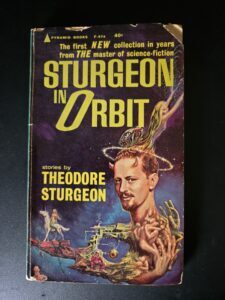
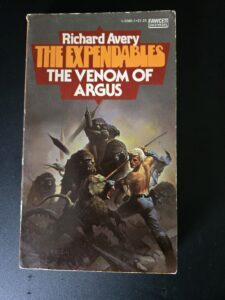
It can be hard to sense the zeitgeist of an era while you are experiencing it, the spirit of decade you are living through, for example. But from a distance, looking back, you can notice trends, assumptions, modes of expression. I just finished a couple of paperbacks, one from the 1950s (though published in 1964) and one from the 1970s. Ten years apart, and yet the distinctions are clear.
Sturgeon in Orbit is a thin collection of Theodore Sturgeon short stories. Reading it reminded me of some of the aspects of science fiction from that era that I appreciated and some that I did not care for. I liked that the stories tended to be premised on an idea, and the story involved considering the application or logical result of that idea. I’m less enthused by the fact that (or so I believe) it was in the fifties that the ideas of sci-fi began to trend less toward the technological and more toward the sociological (a transition from the Campbellian approach, I suppose.) And with few exceptions (e.g. Robert Heinlein) most of the writers of the era or more-or-less coalesced around that promised proto-Camelot apotheosis of wise, compassionate, far-seeing technocratic government objectively guided by science. I can grasp the appeal without succumbing to it: Almost fancifully idealistic in hindsight, yet it offered a numinous polestar for the militantly secular sci-fi authors, substituting for religion. The stories were hit and miss, though none truly bad. My favorite was the shortest, which would have provided the basis for a mid-tier Twilight Zone episode.
The Expendables: The Venom of Argus is the fourth and last of Edmund Cooper’s (writing as Richard Avery) The Expendables series. I have reviewed the previous three before: here; here; and here. It is more of the same, though perhaps even scantier on plot; more setup with a shortened denouement. Still, it delivers unapologetic 1970s men’s fiction. It pulls no punches and is not recommended for readers suffering whatever ailment causes the mental hypersensitivity that currently prevails. As Sturgeon in Orbit is in some ways emblematic of the idealistic 60s, Venom embodies the cynical 70s; Cooper writing of the racial and sexual issues of the decade with a directness and absence of euphemism that has (for both the better and the worse, mostly the worse) since disappeared. With Venom, The Expendables goes out on a particularly uncomfortable, but certainly memorable, note. I got a couple of hours of entertainment out of it.
If you want a few hours of entertainment, may I suggest Semi-Autos and Sorcery, available in print, digital, and audio formats.
March 30, 2025
Mary Stewart’s The Crystal Cave Re-Read Part III: The Last Enchantment
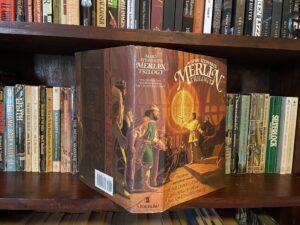
The third book of the Crystal Cave trilogy, The Last Enchantment, swings along pretty fast. I believe it is the shortest of the trilogy. The reason for that, I guess, is that by this point in the Arthurian legend, we’ve about wrapped Merlin. He can get a round of applause from the crew, then jet home while the rest of the cast are getting on with filming the last two acts. Most of the doings of King Arthur and his Knights occur after Merlin was sealed away inside a living tomb by Nimue. So the endless tournaments, fights with giants, quests (including for the Grail), Guinevere’s infidelity, Mordred, and the final tragedy all occur later.
This trilogy is, however, Merlin’s story, not Arthur’s. And Stewart handles it well. She adverts to the Grail Quest. And she commences the Lancelot (here, Bedwyr) and Guinevere romance. The manner in which she handled that was fine, though I’d say I prefer the more nuanced approach John Steinbeck took in The Acts of King Arthur and His Noble Knights. Still, as I say, it was fine, though I personally don’t much care for the idea of Arthur as a knowingly sympathetic cuckold.
Where Stewart really comes through is the matter of Nimue. Though the “surprise” can’t truly be such for those familiar with the legend, it works well. And I like that this narrative treats Merlin with respect and not as a foolish old man easily played by a young, calculating lady. The location of his supposed final resting place was established in the first book and runs smoothly through the trilogy. Stewart’s take on that aspect of the myth is satisfying rather than tragic. She does something that seldom occurs in fiction: she provides her character with an ending of contentment, a sort of “job well done” fulfillment without lingering regrets. That was nice.
One thing I wanted to note, for what it is worth. The character named “Morgian” in the previous book loses the “i” in the third, becoming thus on the nose “Morgan,” as in “le Fay.” That’s fine. I just wonder why. Did Stewart deliberately change the name without comment, or was that a purposeful (or perhaps inadvertent) act by an editor?
So, did the re-read hold up? Yes, entirely. Now I suppose I should get ahold of The Wicked Day and The Prince and The Pilgrim for initial reads.
If you are in the mood for a trilogy, how about Falchion’s Company?
Mary Stewarts The Crystal Cave Re-Read Part III: The Last Enchantment

The third book of the Crystal Cave trilogy, The Last Enchantment, swings along pretty fast. I believe it is the shortest of the trilogy. The reason for that, I guess, is that by this point in the Arthurian legend, we’ve about wrapped Merlin. He can get a round of applause from the crew, then jet home while the rest of the cast are getting on with filming the last two acts. Most of the doings of King Arthur and his Knights occur after Merlin was sealed away inside a living tomb by Nimue. So the endless tournaments, fights with giants, quests (including for the Grail), Guinevere’s infidelity, Mordred, and the final tragedy all occur later.
This trilogy is, however, Merlin’s story, not Arthur’s. And Stewart handles it well. She adverts to the Grail Quest. And she commences the Lancelot (here, Bedwyr) and Guinevere romance. The manner in which she handled that was fine, though I’d say I prefer the more nuanced approach John Steinbeck took in The Acts of King Arthur and His Noble Knights. Still, as I say, it was fine, though I personally don’t much care for the idea of Arthur as a knowingly sympathetic cuckold.
Where Stewart really comes through is the matter of Nimue. Though the “surprise” can’t truly be such for those familiar with the legend, it works well. And I like that this narrative treats Merlin with respect and not as a foolish old man easily played by a young, calculating lady. The location of his supposed final resting place was established in the first book and runs smoothly through the trilogy. Stewart’s take on that aspect of the myth is satisfying rather than tragic. She does something that seldom occurs in fiction: she provides her character with an ending of contentment, a sort of “job well done” fulfillment without lingering regrets. That was nice.
One thing I wanted to note, for what it is worth. The character named “Morgian” in the previous book loses the “i” in the third, becoming thus on the nose “Morgan,” as in “le Fay.” That’s fine. I just wonder why. Did Stewart deliberately change the name without comment, or was that a purposeful (or perhaps inadvertent) act by an editor?
So, did the re-read hold up? Yes, entirely. Now I suppose I should get ahold of The Wicked Day and The Prince and The Pilgrim for initial reads.
If you are in the mood for a trilogy, how about Falchion’s Company?
March 23, 2025
Corpus Christi Beach Weekend and a Birthday
I drove MBW and the HA south to Corpus Christi for the weekend. I like to get out of town for my birthday, out of the country when I get the opportunity. But this year we stayed in the States.
We arrived at our hotel on Thursday afternoon only to discover that the swimming pool was closed. Given that a pool was an essential requirement of our choice of lodging, I immediately canceled the reservation, sat down in the lobby, and located another hotel. This worked out for the best, as the new hotel was beachfront.
As usual, this was a working vacation for me. I don’t really take time off. But at least I can often find nice office space.

The HA spent time in the pool, then on the beach. We dined on bbq at Nueces Brewing. Not a bad Thursday.

Friday we visited the Aquarium. An aquarium is always an easy call, especially this one, which we have visited before. The HA once again hit the pool. Later on I enjoyed an excellent birthday dinner at Railroad Station Seafood and Brewing.


Saturday morning we spent at a neighboring beachfront park after a large breakfast. Then we hung out out most of the afternoon at Lazy Beach Brewing, spending the time chatting with a couple of locals who had brought their daughter and a year-old dog with them, thus ensuring that the HA was entertained.


It certainly didn’t hurt her mood to finish the day with video games at a pizza place, followed by another hour in the pool.

I’ve had worse birthdays. I can only hope that I’ll mark the next swing around the sun at least as enjoyably.
I almost forgot the marketing portion of today’s post. Shame, writer, shame. If you would like to help, retroactively, subsidize my birthday trip, feel free to peruse Amazon’s catalogue of my books and purchase one that speaks to you.



